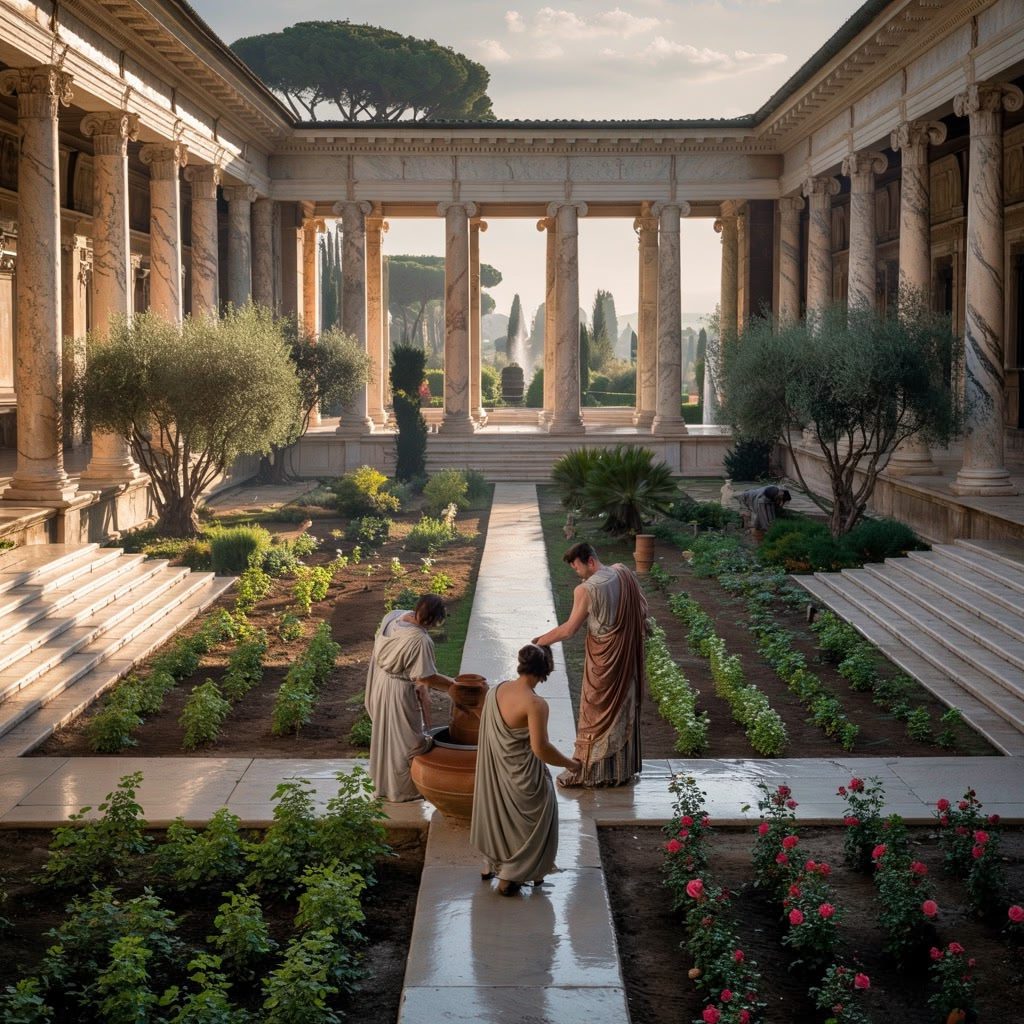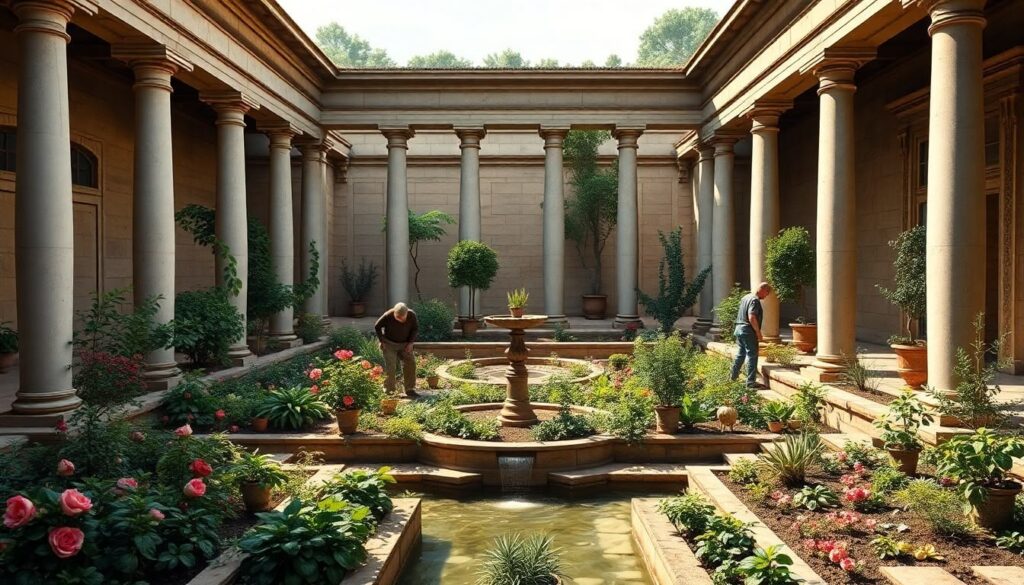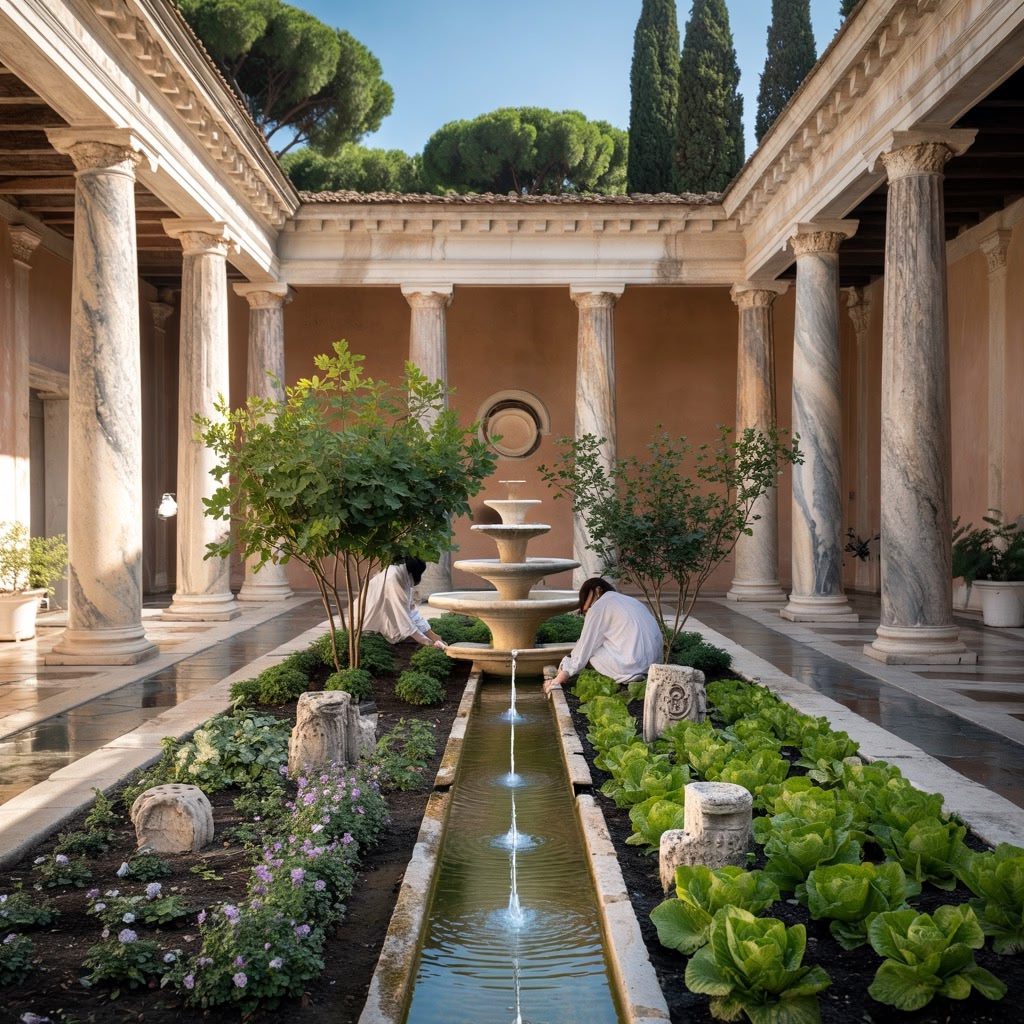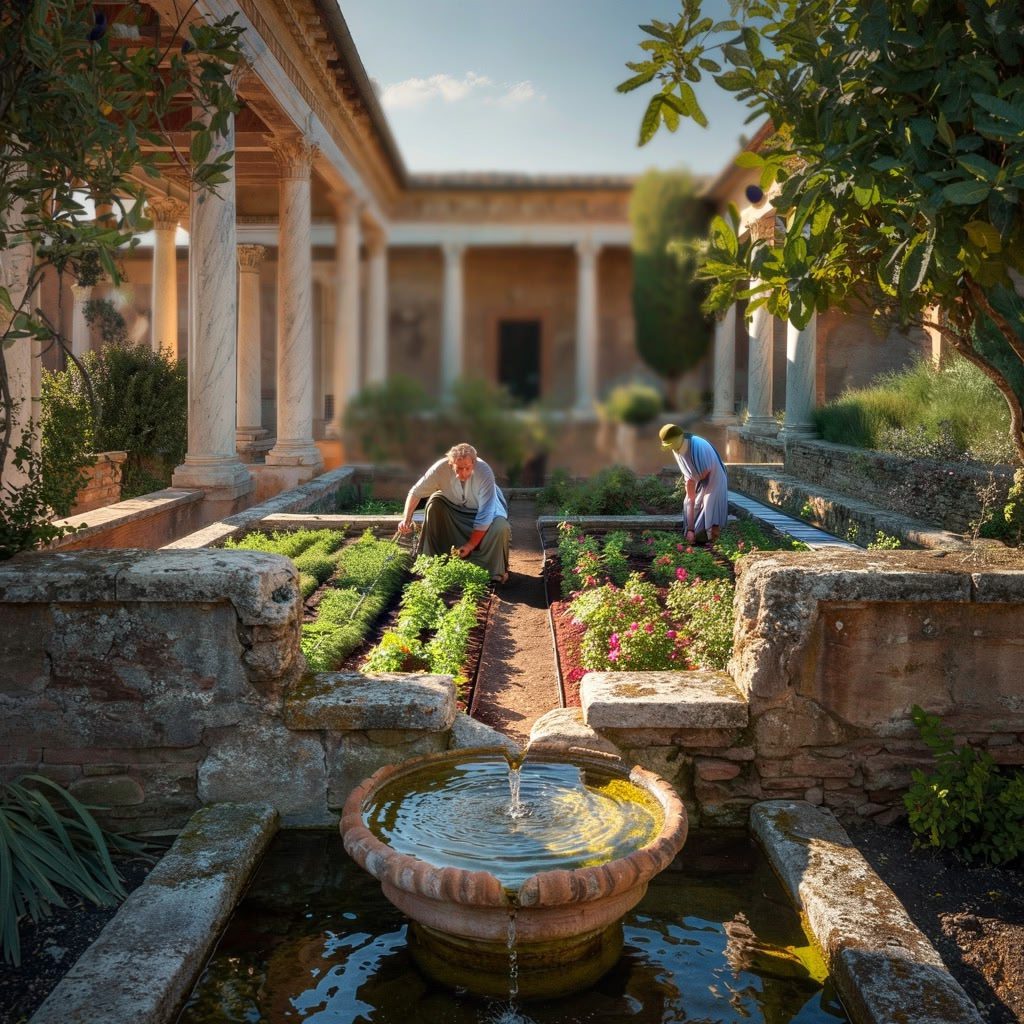Roman villas were not just opulent residences; they were also hubs of horticultural innovation. The gardens of these ancient estates went beyond being mere decorations; they served as lively spaces for botanical experimentation and cultivation.
These gardens represented wealth and status, while also pushing the boundaries of Roman horticulture with groundbreaking planting methods, a wide variety of plant species, and intricate garden design.
Gardens of Power: Horticultural Innovations in Roman Villas delves into the intricate relationship between aesthetics and practicality in these cultivated landscapes. It explores how the owners’ social aspirations and scientific interests shaped their gardens.
This article explores:
- The historical significance of Roman villas and their gardens beyond mere beauty
- The architectural features that influenced garden design
- Important horticultural practices such as the use of ollae perforatae
- The balance between ornamental and practical plants through botanical diversity
- The role of advanced water management systems in nurturing gardens
- The socioeconomic implications behind garden innovations
- The enduring impact on European garden traditions
Discover how Roman villa gardens combined power, prestige, and plant science in ways that still inspire modern landscape architecture.

Historical Context of Roman Villas and Their Gardens
Roman villas were luxurious homes for the wealthy, designed to be both comfortable and functional. These estates had various areas for different activities: places to live, work, store things, and large gardens. The gardens weren’t just there for show; they played a crucial role in the daily life of the villa.
Importance of Gardens in Roman Villas
Gardens served several important purposes in Roman villas:
- Growing food: Many villas relied on their gardens to provide fresh fruits, vegetables, and herbs.
- Healing properties: Certain plants were cultivated for their medicinal benefits, showcasing the Romans’ understanding of natural remedies.
- Recreation and gatherings: Gardens provided peaceful spots for leisure activities, intellectual conversations, or social events.
The design and intricacy of these gardens were greatly influenced by Roman culture and wealth. As landowners became richer through trade, politics, or farming, they had more resources to create diverse plantings and elaborate garden designs. This led to a wide variety of plants being grown, including both local Mediterranean species and exotic plants brought in through trade.
Architectural Harmony in Roman Villas
Roman villa architecture focused on creating a balance between man-made structures and nature. Gardens were designed not only to showcase wealth but also to fulfill practical purposes. This combination of aesthetics and functionality played a significant role in the development of gardening practices within these estates.
The gardens in Roman villas became important places for exploring new ideas about plants and gardening techniques. They went beyond being just beautiful spaces and became sites where scientific knowledge about botany was expanded and practical skills for sustainable living were developed.

Architectural Elements Enhancing Garden Design
Roman villas used clever design to make gardens more than just green spaces. They transformed them into well-planned and immersive environments. Several key features influenced how these gardens were both seen and used.
1. Peristyles: Framing Nature with Columns
Peristyles were covered walkways supported by columns that surrounded gardens. They created distinct outdoor areas within the villa, much like rooms in a house. By enclosing courtyards, peristyles brought order to the space, providing shaded pathways for leisurely walks and directing visitors through carefully arranged plantings. The repetition of columns added a sense of rhythm and balance, seamlessly blending man-made structures with the natural world.
2. Terraces: Mastering Slopes with Layered Gardens
To tackle hilly landscapes, Romans built terraces—flat platforms cut into slopes. This technique allowed them to create organized planting patterns on uneven ground. Terraces not only enhanced the visual appeal of gardens by adding depth and perspective but also provided different climate zones for various plant species. It was an efficient way to combine beauty with practicality, accommodating both decorative and productive gardening.
3. Hydraulic Engineering: Harnessing Water for Life and Beauty
Water played a vital role in Roman garden design, thanks to their advanced engineering skills. They constructed aqueducts and used lead pipes to bring water from distant sources directly into their gardens. This reliable supply enabled the creation of stunning features like fountains, reflecting pools, and small waterfalls—elements that delighted the senses while serving functional purposes.
- Fountains and pools added an artistic touch, making gardens visually captivating.
- Water bodies created cooling effects, moderating temperatures within the garden microclimate.
- Irrigation channels ensured plants received adequate moisture for healthy growth.
The combination of architectural elements—peristyles, terraces—and innovative water systems showcased the Romans’ ability to merge practicality with beauty. Their gardens became not just places of leisure but also symbols of human achievement in design and technology.

Horticultural Innovations: Ollae Perforatae and Plant Cultivation Techniques
Roman villa gardens reveal a fascinating horticultural tool known as ollae perforatae—specialized planting pots characterized by small holes in their walls. Archaeological discoveries of these pots across domestic, commercial, and sacred garden sites highlight their widespread use and importance in Roman horticulture.
These perforated ollae demonstrate an advanced understanding of controlled irrigation. Water could seep gradually through the tiny openings, providing consistent moisture to plant roots without overwatering. This technique reduced water wastage and created optimal growing conditions, especially important in Mediterranean climates where water conservation was vital.
Evidence from villa excavations suggests seasonal planting strategies were employed to maximize garden productivity year-round. The use of ollae perforatae allowed gardeners to regulate soil moisture precisely during different growing seasons, supporting a diverse range of plants adapted to varying climatic demands. Such practices reflect a sophisticated approach to botanical management, balancing ornamental beauty with practical cultivation.
- Ollae perforatae as indicators of Roman gardening expertise
- Controlled watering methods enhancing plant health and growth
- Seasonal adjustments in planting schedules optimizing yield
These innovations contribute significantly to the theme of Gardens of Power: Horticultural Innovations in Roman Villas, showcasing how elite residences combined technology and botany to maintain flourishing gardens that were both functional and symbolic.

Botanical Diversity: Ornamental and Functional Plantings
Roman villa gardens showcased an impressive variety of plants, reflecting the dual purpose of beauty and utility.
Ornamental Plants
Ornamental plants included vibrant flowers such as roses, violets, and lilies. These were cultivated not only for their decorative appeal but also for their fragrances, which enhanced the sensory experience of garden spaces.
Medicinal Herbs
Medicinal herbs formed a vital component of these gardens. Plants like mint, sage, and thyme were grown extensively for their therapeutic properties, addressing common ailments and contributing to the villa’s self-sufficiency in health remedies. The presence of these herbs highlights the practical knowledge Roman gardeners possessed about botanical benefits. This knowledge is akin to modern understanding where certain plants are recognized for their medicinal properties, similar to how herbs are used in contemporary medicine.
Fruit Trees and Vegetables
Fruit trees and vegetables contributed directly to food production within the villa complex. Commonly found fruit trees included figs, olives, pomegranates, and citrus varieties, while vegetables like lettuce, cabbage, and onions supported daily sustenance. This cultivation not only ensured a steady supply of fresh produce but also demonstrated sophisticated agricultural planning.
The careful selection of species balanced aesthetics with function. Gardens served as living displays of botanical expertise where owners could flaunt exotic flowers alongside productive crops. This combination illustrated a deep understanding of plant characteristics and seasonal cycles—an integration of beauty and practicality that defined Roman horticultural mastery.
Water Management Systems in Villa Gardens
Roman villas employed advanced hydraulic systems to ensure efficient water distribution throughout their gardens. These networks included aqueducts, lead pipes, and channels that delivered water from distant sources directly to the villa grounds. Such infrastructure supported irrigation technology that allowed garden areas—whether terraced beds, orchards, or lawns—to receive consistent moisture essential for diverse plant cultivation.
Purposes of Water Features
Water features served multiple purposes beyond visual appeal:
- Fountains and pools acted as focal points enhancing the aesthetic and sensory experience.
- They helped regulate the microclimate by cooling surrounding air through evaporation.
- Flowing water produced soothing sounds, contributing to a tranquil garden atmosphere.
- Reflective surfaces of still pools amplified natural light, brightening shaded peristyles and walkways.
For instance, the elaborate fountains in Sigiriya are a testament to how water features can be both functional and artistic.
Importance of Water Management
The integration of water management was crucial for sustaining both ornamental and functional plantings year-round. Controlled irrigation prevented drought stress while supporting delicate species requiring precise moisture levels. This level of sophistication in hydraulic engineering demonstrated not only technical skill but also an understanding of environmental manipulation to optimize garden productivity and comfort.
Roman villa gardens exemplified how water could be harnessed as a resource, an artistic element, and a climatic moderator—blending utility with luxury in horticultural design.

The Socioeconomic Implications of Garden Innovations
Roman villa gardens served as more than just private retreats; they were powerful symbols of social status and wealth display. The complexity of garden designs and the presence of exotic plants communicated the owner’s access to vast resources and far-reaching trade networks.
Key points illustrate how these Gardens of Power functioned in society:
- Exotic Plantings: Introducing rare species from distant provinces demonstrated both botanical knowledge and economic means. Such plants required specialized care and indicated connections beyond local boundaries.
- Complex Garden Layouts: Elaborate terraces, peristyles, and water features were not merely aesthetic choices but also statements of sophistication and control over nature.
- Innovation as Prestige: Advanced horticultural techniques, including the use of ollae perforatae for irrigation, reinforced elite identity by showcasing mastery of cutting-edge gardening methods.
Elite Romans used their gardens to assert dominance within social hierarchies. The gardens became visual narratives of power, blending natural beauty with technological prowess. This fusion elevated the villa owner’s prestige, distinguishing them from lower classes who lacked such resources.
Gardens operated as living testimonies to wealth and education, reflecting broader cultural values tied to status. Understanding these socioeconomic implications reveals how horticultural advancements went hand-in-hand with expressions of Roman elite identity.
Legacy and Influence on Later Garden Design
The Roman gardening legacy extends far beyond the ancient world, deeply embedding itself in the evolution of European garden traditions. Roman villas established foundational principles in garden layout, plant selection, and water management that later Renaissance and Baroque gardens adapted and refined.
Key aspects of this influence include:
- Structured garden layouts: The use of geometric designs such as peristyles and terraces inspired formal garden styles characterized by symmetry and order. This approach became a hallmark of Italian Renaissance gardens and spread across Europe.
- Integration of architecture and nature: Roman villas combined built elements with horticulture seamlessly, setting a precedent for landscape architecture that balances structural features with natural beauty.
- Water engineering: The hydraulic innovations developed for fountains, pools, and irrigation in Roman gardens informed the sophisticated water displays seen in later European estates.
- Botanical diversity: The combination of ornamental and functional plants reflected a deep understanding of ecology still relevant to modern landscape design.
Recognition of ancient horticultural knowledge highlights how these practices shaped contemporary landscape architecture. Modern gardens benefit from principles first perfected in Roman villas—such as efficient water use, seasonal planting cycles, and multifunctional green spaces—that continue to influence design strategies today. The enduring impact of Roman villa gardens illustrates an early mastery of blending aesthetics with practicality, a balance central to successful landscape architecture.
Conclusion
The Gardens of Power: Horticultural Innovations in Roman Villas exhibit showcases how ancient Roman gardens were more than just pretty spaces. They represented wealth and power while also introducing new methods in growing plants, managing water, and designing landscapes. Understanding the importance of Roman gardens enhances your appreciation for the cultural legacy that influences today’s gardening techniques.
You can apply lessons from this horticultural innovation summary to your own garden by focusing on:
- Balancing beauty and functionality: Combine ornamental plants with edible or medicinal varieties.
- Incorporating smart water management: Use irrigation thoughtfully to maintain healthy plants.
- Embracing architectural elements: Add structural features like terraces or pathways to organize space attractively.
Unlock your garden’s potential by blending historical inspiration with contemporary needs. This approach honors centuries of botanical expertise and transforms your outdoor space into a living tribute to ancient ingenuity.

